Knitting Socks is a popular knitting project choice. Sock knitting becomes addictive! Here’s my guide to sock yarn. There are many yarn types, but some good yarn for knitting suits socks more than others.
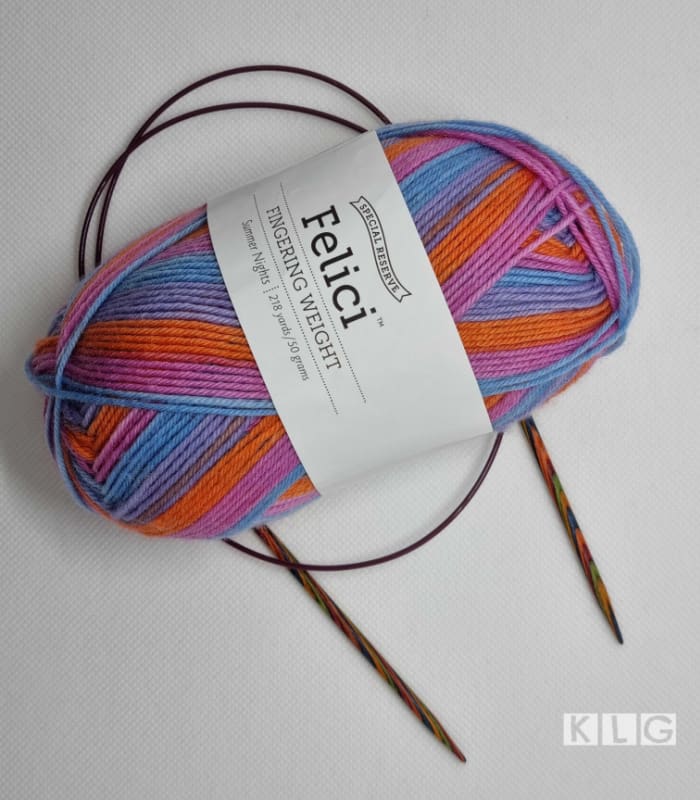
Note: If you click a link on this page and make a purchase, I may receive a commission, but at no extra cost to you. Learn More.
Frustrated Teacher Quits In Disgust, Sells The Farm, Moves The Family Halfway Across The World And… Starts Knitting
What Is The Best Yarn For Knitting Socks?
- My Top Pick – Best Sock Yarn
- Best Luxury Option – Best Worsted Weight Sock Yarn
- Best Budget Pick – KnitPicks Stroll
There are many gorgeous sock patterns to explore color and stitch techniques.
I reviewed, fact checked and updated this post on Oct 7, 2024.
Table Of Contents
Best Sock Yarn Knitters Recommend
Most big brand yarn companies offer it. Knitters recommend the following great sock yarn.
- West Yorkshire Spinners Signature 4 Ply
- KnitPicks Stroll
- Regia 4-Ply
- Schoppel Zauberball – Best Self striping yarn
Paintbox Yarns also has some excellent choices, like Socks Solids, and their general self-striping sock yarns. They have great free patterns to pair with their products.
What Is Sock Yarn?
It’s a super fine yarn. The American Craft Yarn Council places it in the Super Fine category with the symbol number 1. It’s knitted on small needles like 2.25mm or US needle size 1-3. In the US it’s referred to as fingering and 4 ply in the UK, Australia and New Zealand.
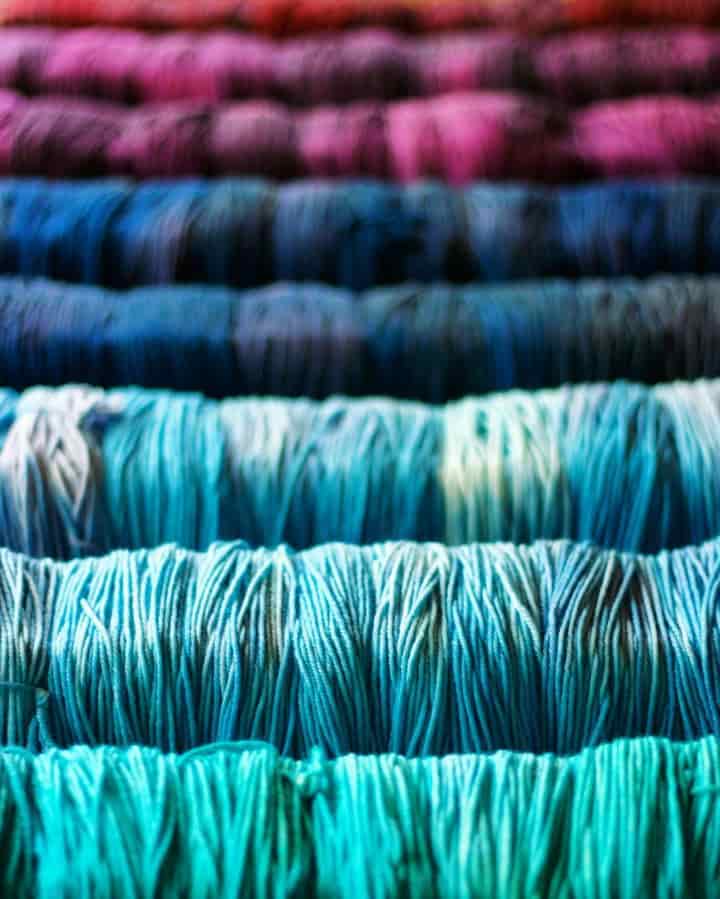
It varies in thickness or yarn weight, like super bulky or worsted weight. These thicknesses are best suited to bed or outdoor socks to go hiking in. It’s often a blend of fibers, making the finished fabric more durable.
If you decide to knit socks, you’ll be in good company! The first ever knitted items, according to archeological records were a pair of knitted socks found in Egypt. They were elaborate pieces of colorwork made with cotton and dyed with berries.[3]
What To Consider In Sock Yarns
Here’s what to consider in the best sock yarns.
Socks Should Hug The Leg
Most people prefer a tight, non-floppy sock. They should hug the leg. You need plied and less yielding yarn, though you still need stretchy yarn.
A blend of wool and nylon gives elasticity. Try KnitPicks Stroll yarn. It’s lovely and soft and an affordable price. It’s amazing how elastic wool is, but reinforced with nylon adds strength. Sock fabrics need to be sturdy.
Socks Need Washing
As they’re worn every day during cooler weather. They stand wear and washing. Avoid yarns that visibly discolor with regular washing. A machine-washable yarn saves time. If you don’t mind hand-washing, choose many other types. I hand wash mine that are made from non superwash fiber.
How Much Yardage?
To see the amount of yarn you need for different sock styles, I’ve written a series of guides. The first is on how much yarn for socks.
Thin Or Thick?
If you like thin socks, choose fingering weight sock yarn 396 yds/3.5oz (400m/100g). Think about what type you want to knit or might like to knit.
Thicker wool like DK weight or sport weight yarn makes bulkier socks. Keep in mind the amount of space in your shoes!

What Knitting Equipment You Have
Use DPNs (Double-Pointed Needles) or circular knitting needles. Knitters recommend these needle options:
- 6″ double-pointed needles
- Two circular needles (a Chiaogoo interchangeable needle set is great)
- Magic loop using one long circular knitting needle to knit two socks at a time
- 9″ circular knitting needles
Tension Of Knitting
Consider what type of tension you have, tight or loose. It’s crucial when working with any sock pattern to check your gauge.
How The Yarn Feels
Some people have heightened sensitivity to scratchy wools. Others have a greater tolerance for rough yarn they’d never bear as scarves or sweaters.
Softness is a consideration for some. Remember, softer yarns don’t stand up to abrasion well. They’re likely to pill and get holes quicker.
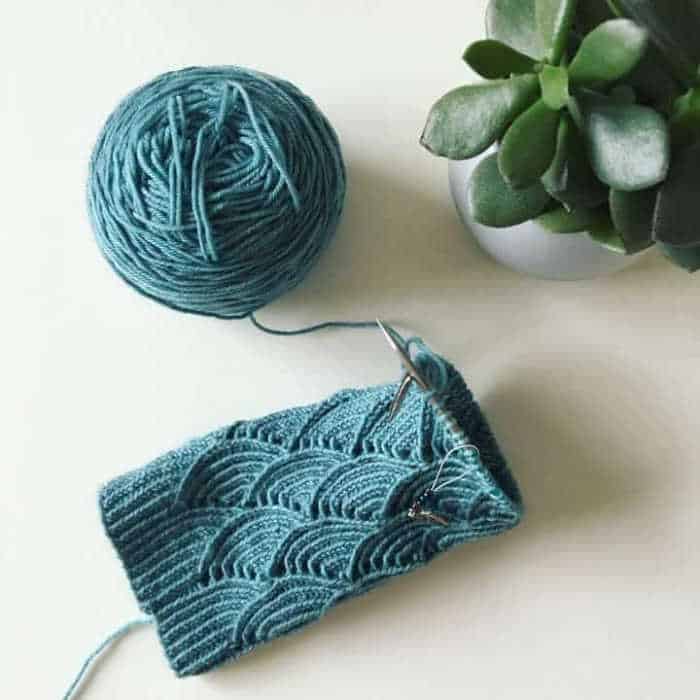
Do You Want Your Stitch To Shine?
Are you a fan of intricate stitch patterns? Plain or ‘kettle dyed’ yarn, the best solid color sock yarn, allows intricate stitch patterns to shine. Dark colors mask textures and cables. Choose lighter colors if you want the pattern to stand out.
Handpainted yarn looks fantastic, but only in simple stitch designs.(1) You could try dyeing your own yarn with Kool-Aid for a unique look.(2) Solid colors are better for a beginner to yarn dyeing.
Self Striping Yarn For Color
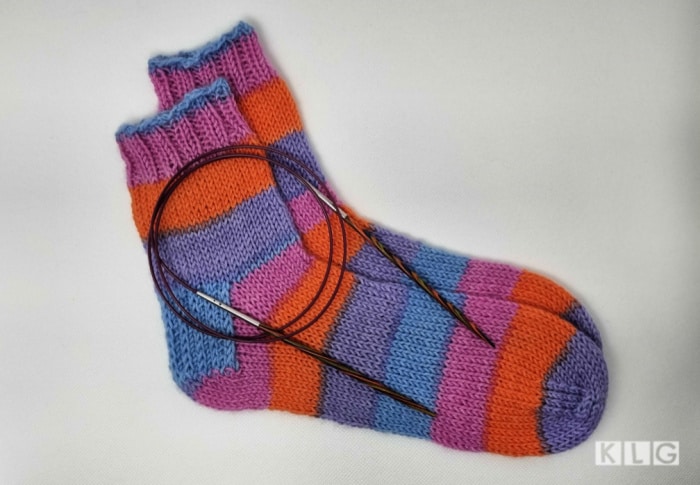
Self-striping yarn is fabulous for colorful, wild sock patterns. Remember, the heel you choose in your sock impacts the stripes. I find the heel turn method, which is said to have originated in Finnish knitting patterns, works best.
If you get this, use the leftovers for a scarf that’s super colorful!
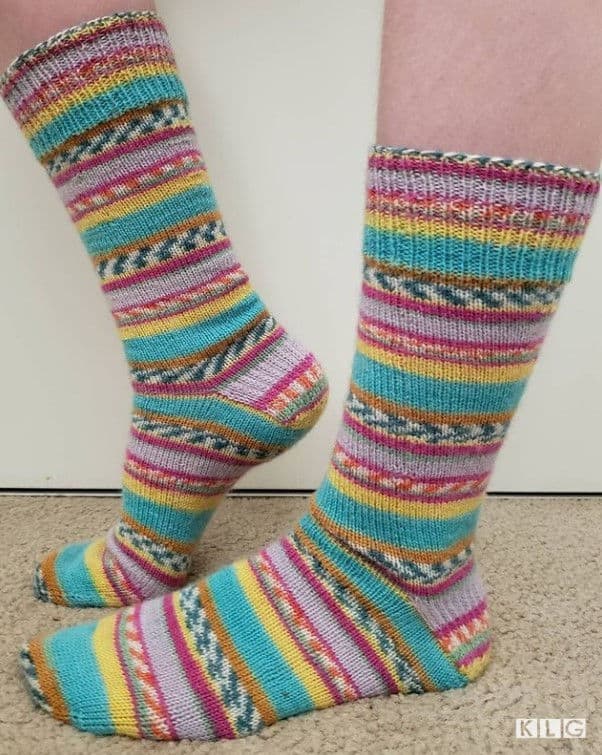
Think Of Your Budget
If you can afford expensive yarn, you want something that lasts. Avid sock knitters don’t recommend silk, bamboo, angora, cashmere, or alpaca, even in blends.

The best silk sock yarn is better for shawls or delicate knitted items. Cotton-blend yarns are also more fragile than pure wool ones. These fibers don’t stand abrasion well. If you live in a warm climate, you’ll want to stick with cotton or cotton-blend yarns. These are the best summer sock yarn.
Pure synthetics won’t provide much long-lasting warmth. This type of yarn holds moisture against your feet, making them cold and clammy with wear. There’s no best acrylic sock yarn because it makes your feet and toes sweat.
If you’re new to knitting socks, start with yarns labeled sock yarns. These are durable and easier to wash than similar weight yarns not made for socks. They are likely to have nylon to reinforce the yarn.
For the best non-wool sock yarn, consider blends of cotton/nylon and bamboo/cotton/nylon. This is the best value yarn if you’re allergic to wool.
Yarn For Socks Needs To Handle Rubbing
There’s a lot of pressure on fibers in knitted socks because they rub your foot, shoe, or ground. If you are making ones to wear when you sleep, the movement of your feet rubbing against the sheets over time will cause the pilling.
Socks Need To Absorb Or Wick Away Moisture
Feet sweat, socks need to wick away moisture to feel (and smell) good. Nothing beats wool. It absorbs up to one-third of its weight in moisture before it feels moist. Some knitters prefer cotton sock yarns, but these don’t absorb moisture. Plant fibers are good if you’re allergic to animal fibers.
Socks Need To Be Washed
Consider superwash yarns, (like superwash merino wool.) Toss these in the washing machine in cold water. The best washable wool sock yarn is labeled ‘superwash.’ However, for non superwash wool, washing by hand isn’t difficult.
Wool blend yarns may need to be washed by hand. It doesn’t take long!
Sock Yarn Weight
Fingering weight, sport, and DK weight ranging in gauge from 6 to 8 stitches per inch. The finer the gauge, the more form-fitting the sock. Knit in worsted-weight at gauges up to 4 stitches per inch.
FAQS About Yarn For Socks
What Are Popular Yarn Blends for Knitting Socks?
Mohair is a wonderful durable fiber when blended with merino wool and nylon. Have cold feet? Nothing beats angora’s heating power. Even a small amount of mohair in a wool sock boosts its heating capacity.
What Is The Best Self Striping Yarns For A Sock?
Self-striping yarn creates fabulous wild stripes when knitting socks. Sock knitting experts suggest the best self-striping has long color changes. Felicini is a great option.
Also consider Regia Pairfect Design Line 4-Ply by Arne & Carlos. The self-striping creates different effects. It’s 75% superwash wool and 25% polyamide, giving it stretch and durability. It’s machine washable.

What Is The Best Worsted Weight Sock Yarn?
Knit Picks Chroma a wonderful worsted weight yarn. As a knitter having a colorful sock is a wonderful thing! The gradual changes can be bold or softer depending on your prefered color palette.
What Is The Best Yarn For Knitting Socks?
Experts like Clara Parkes say the best yarns for socks are elastic. Wool and nylon blends are great. Read her excellent book: The Knitter’s Book of Socks.
 Check Price On Amazon
Check Price On Amazon
Why Are They A Blend Of Wool and Nylon?
Wool has the best bounce and fiber memory. Nylon has the best stretch. This combination of yarns means you have warm feet, they feel comfortable to wear and getting them on is easier. The wool yarn with a percentage of nylon helps to wick away moisture.
Do You Recommend Merino Wool Nylon Fingering To Knit Socks?
Merino wool nylon fingering fibers are excellent as socks yarn. They are my favorites. These create a soft, beautiful to wear fabric. Often found in many beautifully hand dyed options and come packaged as a hank.
Can You Use Cotton For Socks Yarn?
You can, but I wouldn’t recommend it. It’s an absorbent fiber which means it holds moisture. Your feet will feel cold. Cotton also tends to loose shape over time.
What’s The Best Soft Sock Yarn?
The best soft sock yarn is KnitPicks Stroll.
Conclusion
That’s the best sock yarn for knitting socks. I’d love to hear about your preference for sock wool. Leave a note in the comments section below. Enjoy your knitting 🙂
References
- Sulcoski, Carol. Knitting Socks with Handpainted Yarn. Penguin, 2013.
- Caplice, Elizabeth. “Picking or throwing.” Lifted Brow, The 1 (2007): 39-41.
- Parkes, Clara. The Knitter’s Book of Yarn. Potter Craft, 2011.
- Magazine, Vogue Knitting. 2007. Vogue Knitting: The Ultimate Sock Book: History, Technique, Design.

I’ve never knitted before. How do I learn to knit socks and blankets?
Hi Jalene. I have suggestions for books for learning how to knit socks and blankets in my post. Have fun learning to knit. Cheers Jodie
I am wondering if a blend of 40 cashmere, 40 Brushtail Possum down, 20 mulberry silk would be good for socks? My daughter wants very light weight socks. Recommended needle for this yarn is 1.
Another option is Autermann Kid Silk. 75 mohair 25 silk. Very fine yarn. Would I need to add a yarn with nylon or some other addition because this is so fine and socks often need a strong fiber?
Crazy but she loves silk in her socks. Any advice appreciated.
Thank you very much.
Evelyn
Hi Evelyn. I asked some experts on Ravelry and their responses will hopefully help. Cheers Jodie
From Anita –
There are plenty of lovely sock yarns (i.e. fingering or light fingering weight, with a tight twist that wears well) with 10, 20 or even more percent of silk. But, I wouldn’t suggest making “socks for wearing in shoes” with either of those you suggested – the one with possum down and cashmere being 80% will be too soft to wear well, and the mohair silk will wear well but has no stretch/recovery and will make baggy socks, because you’ll have to make them a tad larger so that they can be gotten on.
If she wants “light” socks, consider a merino/silk blend, with or without mohair or cashmere, and use a lacey (holey) pattern for the socks. Also choose one of the sock yarns that’s on the thin side (450 or more yds per 100g), in the Ravelry database those would mostly be in the “light fingering” category if you want to do a search. Here’s one: Serenity Silk plus which is 500 yds/100g. However, when I search projects done with it, they are nearly all shawl-y and only a very few socks, which makes me wonder about its longevity.
Another thought – when she wants “light” socks, does she mean thin, or cool? there are non-wool sock yarns, too.
Recommended needle size on yarns for socks is often not what the ball band suggests (which may be for shawls or other drapey things) but several sizes smaller. I hope you’re ok with knitting on multi-zero size needles ‘cause that’s almost certainly what you’re gonna end up with 🙂
From Michelle-
You can consider doing most of the sock in a stronger yarn (or at least the toe/ball of the foot and heel), and use the softer yarn for the rest of the sock. Knees Up is an example of using a different yarn for part of the sock (though this specifically makes more legwarmer socks). I don’t think either of those yarns are going to work well for a sock otherwise, unfortunately. Both are too soft for the wear you need socks to go through. ETA: There’s also Zimmerman’s Moccasin Socks (November), which I haven’t knit but which have replaceable soles. You might be able to get away with a good sock yarn for the sole, and one of your softer yarns for the rest).
Hello I would like to start making socks. I am very allergic to wool. What is a good blend or type of yarn that would work for me? I have no idea which yarn to start with. Everything has wool in it.
Thanks 🙂
Annie
Hi Anatasia. I found 72% Cotton, 18% Poliamide, 10% Polyester works well for socks by Regia. Cheers Jodie
I’m making a triceratops, which is a stuffed animal so I don’t want it to stretch and they recommended using yarn #1. Where can I buy it?
Hi Lannie. This yarn is fingering yarn with the number symbol #1. The number one is on the label and this is from the Craft Yarn Council’s standard weight system. To buy yarn online, I recommend Knit Picks. You can find fingering or sock yarn online if the label says #1. The Knit Picks Comfy yarn might make a good stuffed animal. It’s Pima cotton and acrylic. Have fun making your triceratops. Cheers Jodie
I love to knit and I am really slow at it, is their any tricks their is to knit faster?
Hi Matilda. I have a post on Continental Knitting and another fast style; Portuguese Knitting. Cheers Jodie
Hi! Love your website, so I thought maybe you could help me. I’ve made a gazillion socks from one particular pattern. It’s called bed socks and I use worsted weight. I wear them as slippers but they tend to wear out fairly quickly. I’m also diabetic so I need something that won’t bind around the ankles. Any ideas for a fingering yarn (using a regular sock pattern I have) that would make it loose enough without binding? Thanks so much!
Hi Cheryl. I’ve used 75% superwash merino and 25% nylon fingering weight and find them stretchy. Cheers Jodie
What is your favorite sock yarn if price is no problem? I find the Knit picks yarn not to my liking.
Hi Judi. I’ve knitted socks in superwash merino/nylon blends from Indie Yarn dyers. I’ve also knitted socks in 100% wool like Schoppel Wolle Zauberball. If price is not an issue, do you have a local yarn dyer who offers merino/nylon blends? It would be wonderful to support them and I’m sure you’d find the colorways beautiful. Or if you have a local yarn store, pop in and see their range of sock yarns. Feel them in your hands, as I know when I knitted with the Zauberball wool it wasn’t as soft as the superwash merino/nylon blend from the indie dyers. Let me know how you get on and what you ended up choosing. I’d love to hear about your experiences. Cheers Jodie